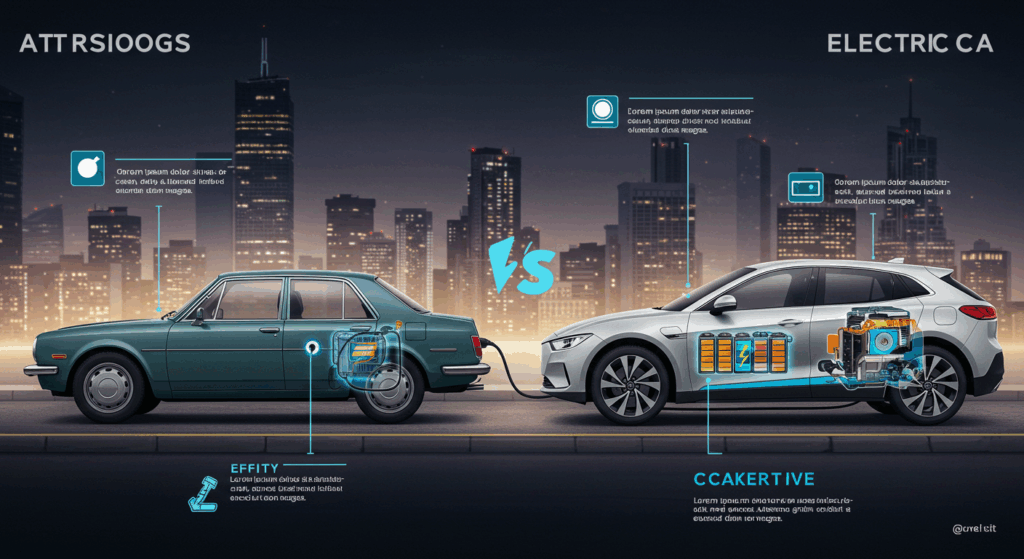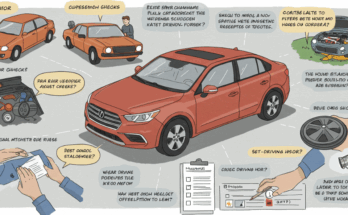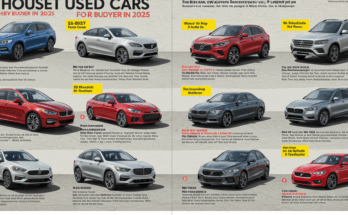As the automotive industry accelerates toward a sustainable future, the debate between hybrid and electric cars has never been more relevant. In 2025, with advancements in technology, shifting consumer preferences, and evolving infrastructure, choosing between a hybrid or an electric vehicle (EV) can feel overwhelming. This blog post dives deep into the pros and cons of both options, comparing costs, performance, environmental impact, and practicality to help you make an informed decision.
Understanding Hybrid and Electric Cars
Before diving into the comparison, let’s clarify what hybrid and electric cars are:
- Hybrid Cars: These vehicles combine a traditional internal combustion engine (ICE) with an electric motor. Hybrids come in various forms, including mild hybrids (where the electric motor assists the gas engine), full hybrids (capable of short electric-only driving), and plug-in hybrids (PHEVs, which have larger batteries that can be charged externally for extended electric-only range).
- Electric Cars: Fully electric vehicles run solely on electricity stored in batteries, producing zero tailpipe emissions. They require charging from external sources, such as home chargers or public charging stations.
Now, let’s explore the key factors to consider when choosing between these two options in 2025.
Cost Considerations
Upfront Costs
In 2025, the upfront cost of electric vehicles remains higher than that of hybrids, though the gap is narrowing. EVs like the Tesla Model 3 or Nissan Leaf start around $35,000–$40,000, while premium models like the Rivian R1T or Lucid Air can exceed $70,000. Hybrids, on the other hand, are generally more affordable. For example, a Toyota Corolla Hybrid starts at approximately $25,000, and even luxury PHEVs like the Lexus NX 450h+ are priced around $50,000.
However, government incentives can offset EV costs. In the U.S., federal tax credits of up to $7,500 are still available for qualifying electric vehicles, depending on battery size and manufacturing location. Some states offer additional rebates, making EVs more competitive. Hybrids, especially non-plug-in models, often qualify for smaller or no incentives, though PHEVs may still receive tax credits.
Long-Term Costs
When it comes to long-term ownership, EVs typically have lower operating costs. Electricity is cheaper than gasoline on a per-mile basis, and EVs have fewer moving parts, reducing maintenance expenses like oil changes or transmission repairs. According to recent estimates, EVs cost about $0.04–$0.06 per mile in electricity, compared to $0.12–$0.15 per mile for gas-powered hybrids.
Hybrids, however, offer savings over traditional gas vehicles. Full hybrids achieve 40–60 MPG, and PHEVs can operate on electricity for 20–40 miles before switching to gas, reducing fuel costs for short commutes. Maintenance for hybrids is more expensive than for EVs but less than for conventional cars.
Resale Value
Resale value is another factor. EVs have historically depreciated faster due to battery degradation concerns and rapid technological advancements. However, in 2025, improved battery longevity and growing demand for used EVs are stabilizing their resale values. Hybrids, particularly from reliable brands like Toyota, tend to hold their value well due to proven durability and widespread consumer trust.
Performance and Driving Experience
Power and Acceleration
Electric cars excel in performance. Their instant torque delivery provides rapid acceleration, making even entry-level EVs feel sporty. For instance, the 2025 Hyundai Ioniq 6 can go from 0 to 60 mph in under 5 seconds. EVs also offer a smooth, quiet ride, free from engine noise or gear shifts.
Hybrids vary in performance. Full hybrids prioritize efficiency over power, with acceleration that’s adequate but not thrilling. PHEVs, like the Toyota RAV4 Prime, can deliver impressive performance by combining electric and gas power, often rivaling EVs in short bursts. Mild hybrids provide a slight boost to gas engines but don’t match the responsiveness of EVs or PHEVs.
Range and Refueling
Range anxiety remains a concern for EV buyers, though 2025 models have made strides. Most EVs now offer 250–350 miles of range per charge, with high-end models like the Tesla Model S exceeding 400 miles. Charging times depend on the charger type: Level 2 home chargers take 6–8 hours for a full charge, while fast chargers can deliver 80% capacity in 20–30 minutes. However, public charging infrastructure, while improving, isn’t universally reliable, especially in rural areas.
Hybrids shine in convenience. Full hybrids don’t require plugging in, relying on regenerative braking to recharge their small batteries. PHEVs offer 20–40 miles of electric range, ideal for daily commutes, and can switch to gas for longer trips. Refueling a hybrid takes minutes at any gas station, making them more practical for drivers without home charging or those who frequently travel long distances.
Environmental Impact
Emissions
Electric cars are the clear winners in reducing tailpipe emissions, producing none. However, their environmental impact depends on the electricity source. In regions with coal-heavy grids, EV emissions (from power plants) can approach those of efficient hybrids. In 2025, as grids incorporate more renewable energy, EVs are becoming cleaner. Lifecycle emissions, including manufacturing, also favor EVs over time, especially with advancements in sustainable battery production.
Hybrids reduce emissions compared to traditional gas cars but can’t match EVs. Full hybrids emit less CO2 due to their high fuel efficiency, while PHEVs can operate emission-free for short distances. However, their reliance on gasoline limits their long-term environmental benefits.
Battery Production
Battery production for both EVs and PHEVs raises environmental concerns. Mining lithium, cobalt, and nickel is resource-intensive and can harm ecosystems. EVs require larger batteries (50–100 kWh), amplifying their production footprint. Hybrids, with smaller batteries (1–20 kWh), have a lighter impact in this regard. In 2025, recycling programs and ethical sourcing initiatives are mitigating these issues, but challenges remain.
Practicality and Lifestyle Fit
Charging Infrastructure
EVs require access to charging, ideally at home. Installing a Level 2 charger costs $500–$2,000, plus potential electrical upgrades. Renters or those without dedicated parking face challenges, relying on public chargers, which can be inconvenient or costly. In 2025, urban areas boast robust charging networks, but rural regions lag behind.
Hybrids, especially non-plug-in models, require no charging infrastructure, making them ideal for drivers without home charging. PHEVs offer flexibility: charge at home for electric driving or use gas for longer trips. This versatility suits diverse lifestyles, from city dwellers to road-trippers.
Space and Features
Both hybrids and EVs come in various body styles, from sedans to SUVs. EVs often sacrifice cargo space for battery placement, though clever designs like the Ford Mustang Mach-E maximize utility. Hybrids, with smaller batteries, typically offer more interior space and conventional layouts. In 2025, both options feature advanced tech, including driver-assistance systems, infotainment, and connectivity, with little difference in quality.
Weather and Terrain
Cold weather reduces EV range by 20–30%, and heating the cabin draws additional power. Hybrids, relying on gas for heat and propulsion, perform better in extreme climates. For off-road or rugged terrain, hybrids like the Toyota Highlander Hybrid or PHEVs like the Jeep Wrangler 4xe offer capable all-wheel-drive systems. EVs with dual motors, like the Rivian R1T, excel off-road but may struggle with range on long, remote journeys.

Which Should You Choose in 2025?
The choice between a hybrid and an electric car depends on your priorities, lifestyle, and budget. Here’s a quick guide to help you decide:
- Choose an Electric Car if:
- You have access to home charging or reliable public chargers.
- You prioritize zero tailpipe emissions and lower operating costs.
- You enjoy a quiet, high-performance driving experience.
- You drive mostly in urban or suburban areas with moderate daily mileage.
- Government incentives make EVs affordable for your budget.
- Choose a Hybrid Car if:
- You lack home charging or live in an area with limited charging infrastructure.
- You frequently take long road trips or live in rural areas.
- You want a balance of fuel efficiency and refueling convenience.
- You prefer a lower upfront cost or can’t access EV incentives.
- You need a vehicle that performs reliably in extreme weather or rugged conditions.
The Future of Hybrid and Electric Cars
In 2025, both hybrid and electric cars are viable options, with neither being a one-size-fits-all solution. Hybrids offer a practical bridge to electrification, combining efficiency with familiarity. EVs represent the future, with rapid advancements in range, charging, and sustainability. As battery tech improves, charging networks expand, and renewable energy dominates, EVs will likely overtake hybrids in popularity. However, hybrids, especially PHEVs, will remain relevant for years, catering to diverse needs.
Conclusion
Choosing between a hybrid and an electric car in 2025 requires weighing costs, performance, environmental impact, and practicality. EVs excel in sustainability and driving dynamics but demand charging access and a higher initial investment. Hybrids offer versatility and convenience, ideal for those transitioning from gas vehicles or facing infrastructure limitations. By assessing your driving habits, budget, and values, you can confidently pick the vehicle that best suits your life. Whether you go hybrid or electric, you’re taking a step toward a greener future.



